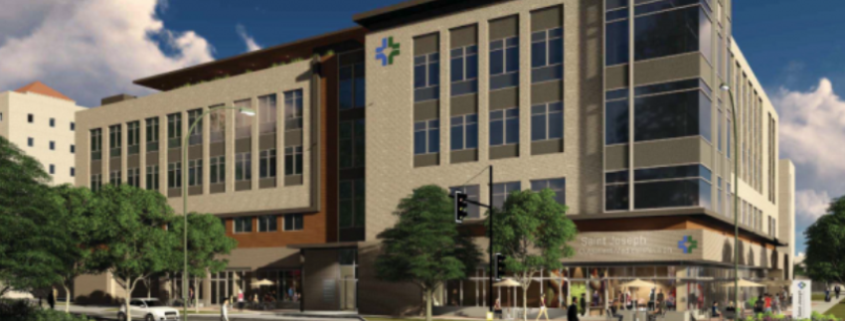Fidelis To Develop Five-Story, 100,000 SF Facility For SCL/Saint Joseph In Denver
Fidelis Healthcare Partners, a new healthcare real estate venture established by the same leaders who previously built the successful Trammell Crow Company/CBRE Healthcare Services and Development business, has announced its first project.
Fidelis Healthcare Partners has recently finalized an agreement to develop the five-story, 100,000-square-foot Saint Joseph Medical Office Pavilion on the Uptown Denver campus of Saint Joseph Hospital.
Saint Joseph is one of the leading medical campuses in SCL Health, a non-profit, faith-based health system with 11 hospitals in three states. Saint Joseph Hospital’s new $650 million, 375-bed acute care facility opened in late 2014. The campus was rated one of America’s 50 Best Hospitals by Healthgrades in 2017 and 2018.
The new Saint Joseph Medical Office Pavilion will be located on a prominent 1-acre site on the campus at the intersection of Park Avenue, Ogden Street and 18th Avenue. Three floors will be dedicated to Class A medical office space; the ground floor will house convenience retail and restaurant uses; and the rooftop will offer wellness/fitness and entertainment options. The project also includes ground-level, covered parking for physicians and an adjacent parking lot that will offer free parking for patients, visitors and tenant employees.
Kevin O’Neil, president and CEO of Fidelis Healthcare Partners, says he’s often optimistic when competing for new development deals but, as a start-up company, he knew it would be a challenge to be selected through a competitive request for proposals (RFP) process.
“We were up against some strong, established national healthcare real estate development firms, as well as local firms – seven final bidders in all,” says Mr. O’Neil. “I think one reason Saint Joseph selected our firm is because we brought a great deal of thoughtfulness and creativity to our development concept.
“For example, we developed a plan for how to build the best, most complete patient experience on a relatively small urban edge site. We also devised a solution for parking that would meet everyone’s needs while being included in the cost of development, yet still ensuring affordable rent for physicians.”
“We’ve also had the opportunity to work with a variety of executives within the system over the years, and through that earned their trust and confidence that we would deliver great outcomes for the hospital and their doctors,” adds Mark C. Allyn, chief investment officer with Fidelis Healthcare Partners.
Mr. Allyn also notes, “In addition, after its substantial investment in the replacement hospital, Saint Joseph was looking for a developer with efficient capital who was willing to assume financial lease-up risk for the new pavilion. We assured Saint Joseph’s leadership that we had the resources in place together with long term efficient capital and remain dedicated to meeting their needs.”
Fidelis Healthcare Partners recently finalized a joint venture (JV) with a new capital partner: a major state retirement fund advised by Bentall Kennedy, a leading investment management firm and a longtime partner in previous ventures with Mr. O’Neil and Mr. Allyn.
“We clearly conveyed to the Saint Joseph leadership that the Fidelis principals are committed to giving our full attention to their deal,” he says. “When you hire our firm, you’re going to get us – hands-on healthcare experience and partner-level involvement all the way through.”
Saint Joseph hospital officials said the medical pavilion, which is scheduled to be completed in the second quarter of 2020, will fill an important need.
“The Saint Joseph campus is strategically located in central Denver, adjacent to the downtown business district, the River North (RiNo) area and many thriving residential areas,” says Jamie Smith, president of Saint Joseph Hospital. “In addition to the new 375-bed Saint Joseph Hospital, the campus has two medical office buildings totaling about 250,000 square feet. However, the campus has proven to be so popular that there’s a waiting list for space, and our existing medical office buildings are 99 percent leased. The new medical pavilion, with a mix of retail and medical office uses, will be a fantastic addition to our campus. The new space will be a key to our continued growth, which ultimately means more services and value for the growing central Denver community.”
The owner of the medical pavilion will be Fidelis Healthcare Strategic Partners, a joint venture between Fidelis and the previously mentioned state pension fund advised by Bentall Kennedy, and the property manager will be Fidelis Healthcare Partners. The entire Fidelis consultant team is Denver-based and headquartered. This includes: architect Boulder Associates, contractor Saunders Construction and healthcare broker CBRE-Denver Healthcare Services.
Fidelis Healthcare Partners is affiliated with Houston-based Fidelis Realty Partners Ltd., a real estate development firm with the biggest retail footprint in the Houston area and more than $3 billion in retail assets across the Southwestern United States. Fidelis Healthcare Partners was launched in September 2017 and finalized its joint venture agreement with Bentall Kennedy in September.
Mr. O’Neil said the retail expertise of Fidelis Realty Partners will be a significant asset for leasing and managing the street-level and rooftop retail space in the new Saint Joseph Medical Office Pavilion.




